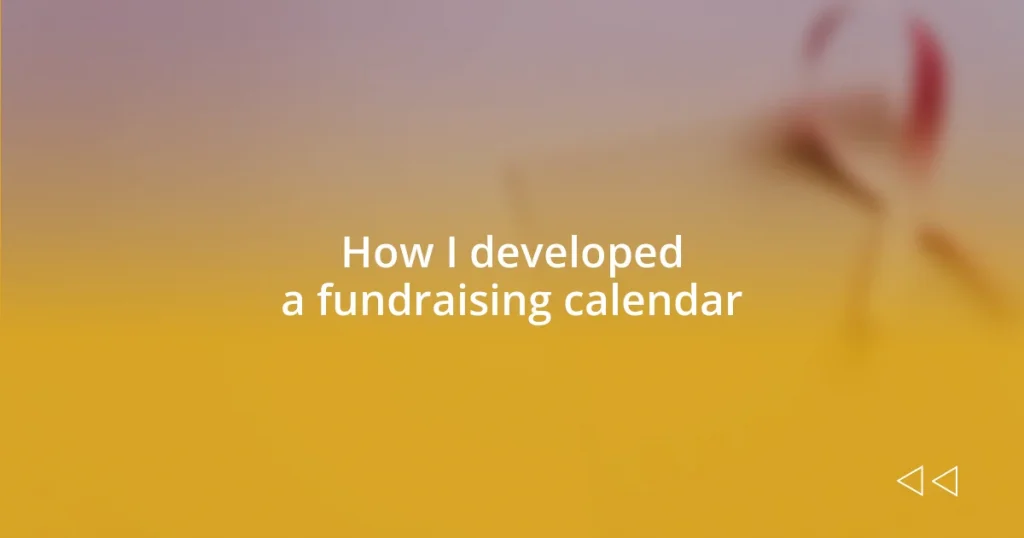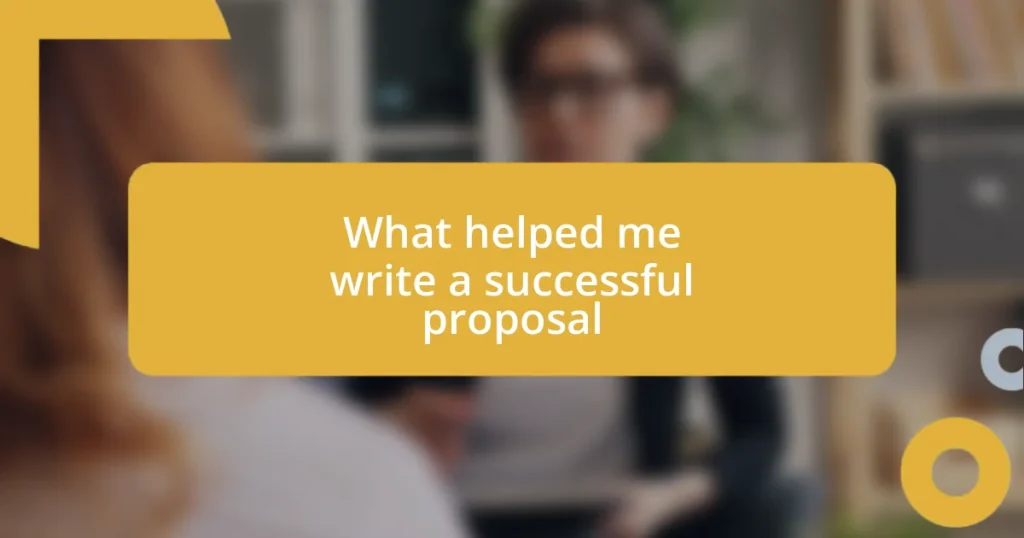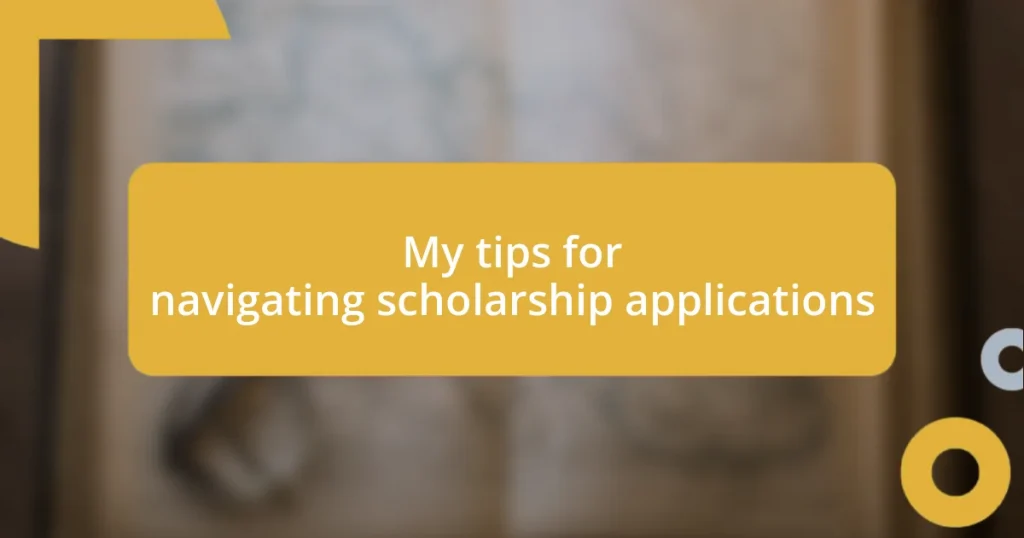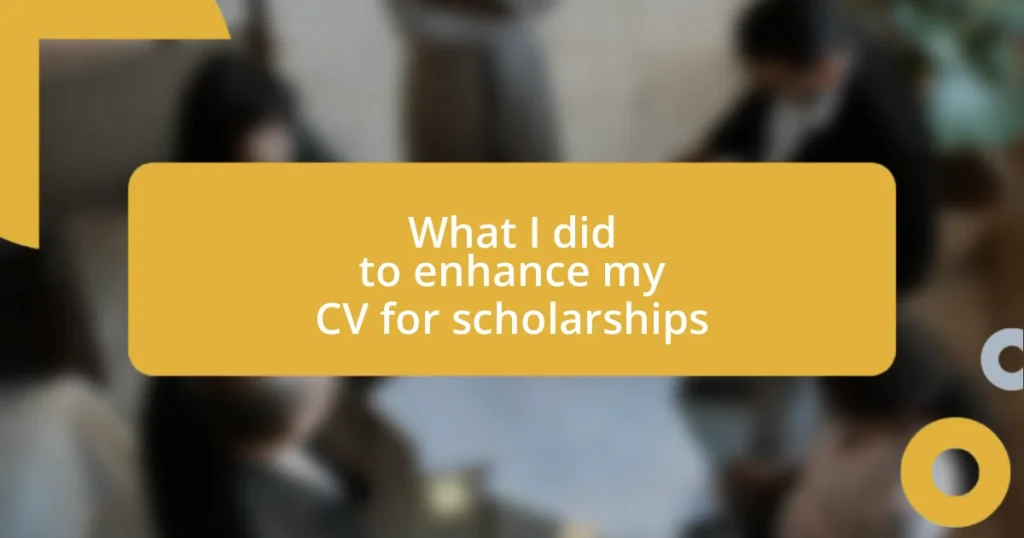Key takeaways:
- Understanding your organization’s goals and audience is crucial for creating an effective fundraising calendar that resonates with supporters.
- Utilizing historical data and collaborative partnerships can enhance event planning, maximizing community engagement and fundraising success.
- Regular evaluation and flexibility in the calendar allow for adjustments based on feedback and unexpected opportunities, improving team morale and productivity.
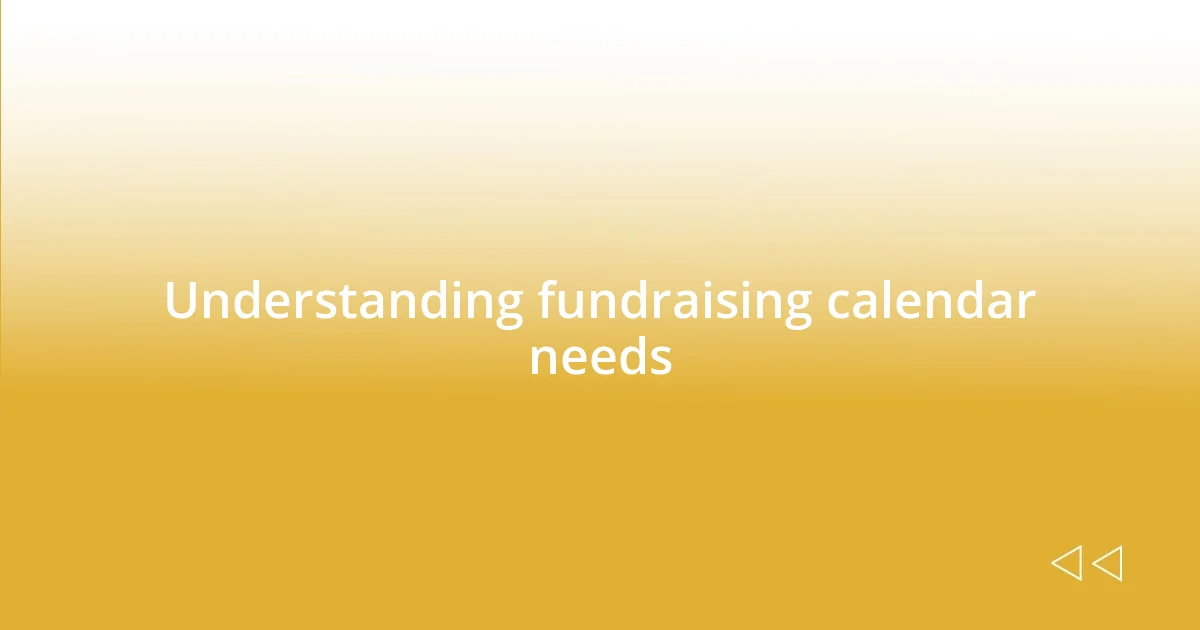
Understanding fundraising calendar needs
When I started to think about my fundraising calendar, I realized it was essential to understand the specific needs of my organization. What events and initiatives are we passionate about? By mapping out our goals, I was able to create a structure that aligned with our mission, ensuring that every activity contributed to our overall objectives. Do you know what your fundraising goals are?
Another aspect I found crucial was audience engagement. I remember brainstorming with my team about what truly resonates with our supporters. Knowing our audience meant we could tailor events to their interests, making participation more likely and impactful. Isn’t it satisfying to see your community excited about something you’ve organized that really speaks to them?
Finally, considering the timing of our events was a game-changer. I still vividly recall juggling multiple responsibilities and realizing that spreading our events too thin could dilute our efforts. By aligning our fundraising activities with relevant dates or community events, I learned to maximize attendance and enthusiasm. Have you thought about how timing impacts your fundraising success?
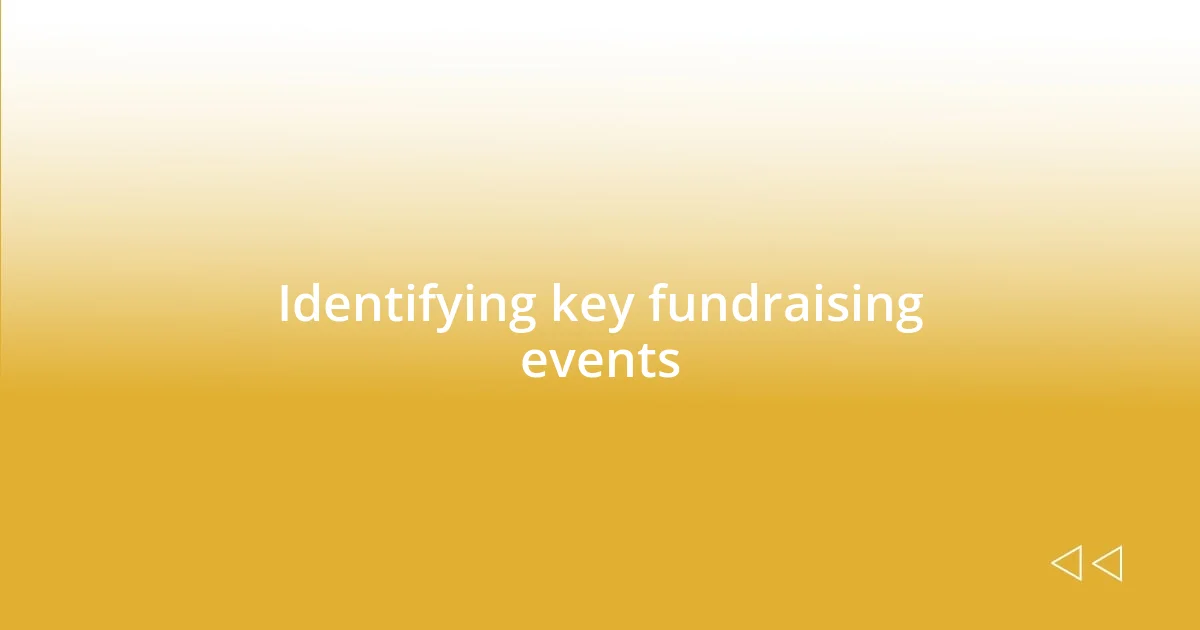
Identifying key fundraising events
Identifying key fundraising events requires a blend of strategic planning and creative brainstorming. Reflecting on my own experiences, I found that analyzing past events provided invaluable insights. For example, after examining participation rates and fundraising totals from previous years, I identified the events that truly resonated with our donor base, like the annual charity race. It taught me the importance of focusing on what works while also being open to innovation.
From my perspective, it’s crucial to not only review past successes but also to consider potential partnerships. Collaborating with local businesses or community organizations can lead to fresh ideas and broader reach. I remember organizing a combined event with a local restaurant that not only brought in substantial funds but also fostered a sense of community. Combining efforts can create events that are not only enjoyable but also effective in gathering support. How do you identify potential partners for your fundraising endeavors?
Lastly, I discovered that aligning events with national observances or awareness months can significantly boost visibility. For instance, planning a fundraiser during Breast Cancer Awareness Month allowed us to tap into a larger conversation already taking place. I felt a surge of pride as our campaign garnered attention not just locally, but on social media channels. Timing events to sync with broader awareness efforts helps to amplify our message. Are there local or national events you could leverage for your initiatives?
| Event Type | Key Considerations |
|---|---|
| Annual Charity Race | Proven engagement; strong community support |
| Partnership Events | Broader reach; shared resources |
| Awareness Month Fundraisers | Amplified visibility; aligned messaging |
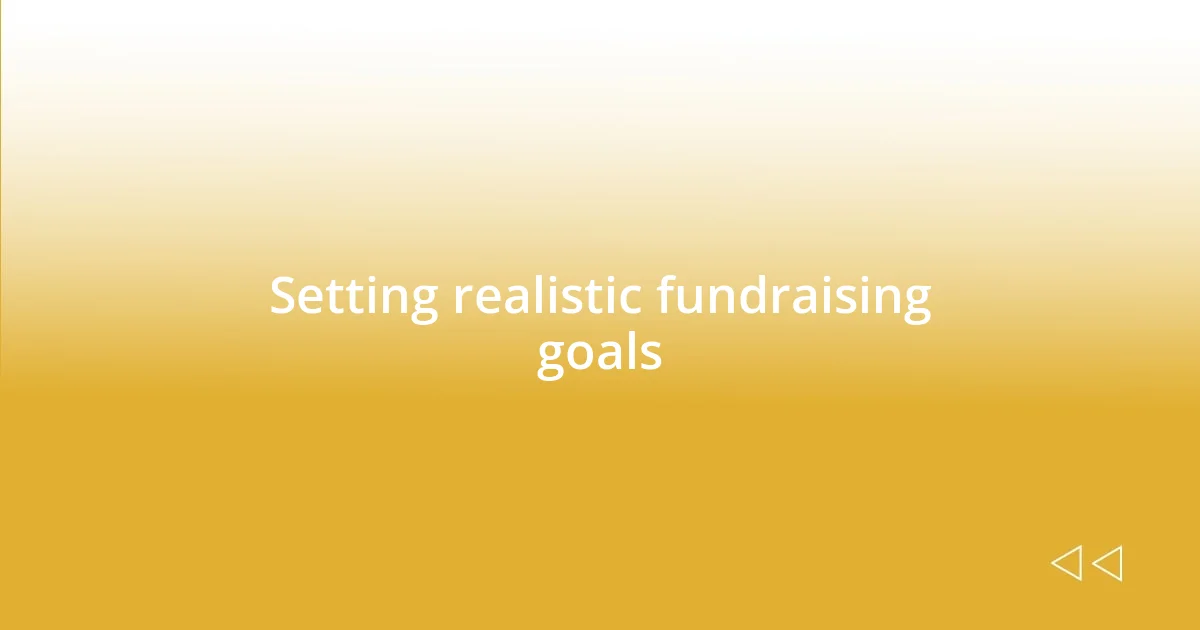
Setting realistic fundraising goals
Setting realistic fundraising goals is the backbone of any successful campaign. I remember when I first started setting targets, I was eager and perhaps a bit too ambitious. It took me a while to realize that overestimating our capabilities not only led to disappointment but also to burnout among our team. Instead, I learned to focus on achievable goals based on our past performance and current resources. By breaking down larger objectives into smaller, manageable chunks, I found it easier to maintain momentum and celebrate those small victories along the way.
To help you set realistic fundraising goals, consider these key factors:
– Historical data: Analyze previous fundraising results to gauge what is realistically achievable.
– Team capacity: Assess the resources and time your team can commit to fundraising efforts.
– Donor engagement: Evaluate the giving patterns of your supporters to anticipate their potential contributions.
– Community trends: Stay aware of any local economic factors that might affect donor participation.
Each of these elements not only contributes to a well-rounded goal-setting process but also creates a strong foundation for accountability and motivation within your organization. I found that when our goals felt attainable, our team became more engaged, leading to a more energetic and committed fundraising atmosphere.
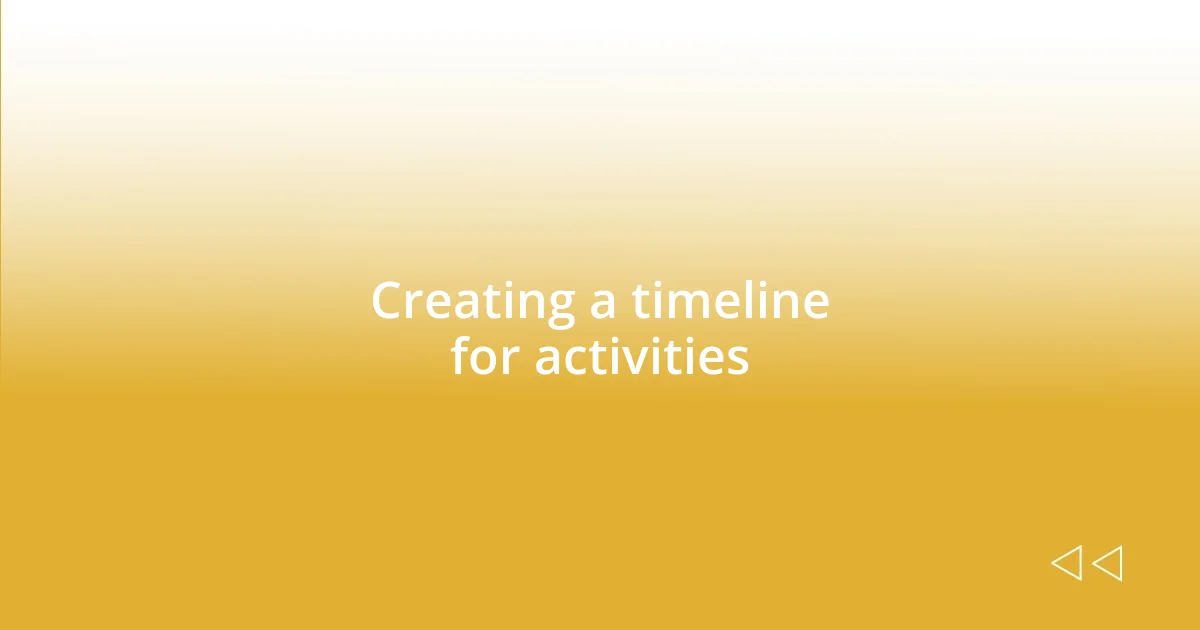
Creating a timeline for activities
Creating a timeline for activities is a crucial next step in shaping your fundraising calendar. When I first mapped out a timeline, I found it helpful to visualize all the events in a calendar format. I would color-code them according to themes or type of activities, which made it much easier to see potential overlaps or gaps. Have you ever tried this method? I was amazed at how a simple visual representation transformed my planning process.
As I scheduled events, I also double-checked that we weren’t putting too much pressure on our team or our supporters. I learned the hard way that spacing out major activities allows for better engagement and energy from everyone involved. One year, I clustered several events back-to-back, and it was overwhelming—staff burnout was real. Isn’t it vital to keep your team motivated and excited?
I also made it a point to incorporate feedback from our previous events into my timeline planning. I vividly remember an instance where we adjusted the date of our annual gala after hearing suggestions during debriefs. It turned out that moving it a week earlier dramatically improved attendance. What are some ways you can gather genuine feedback to refine your timelines? Engaging your team in this conversation not only strengthens ties but also enhances the overall planning process, creating a sense of shared ownership.
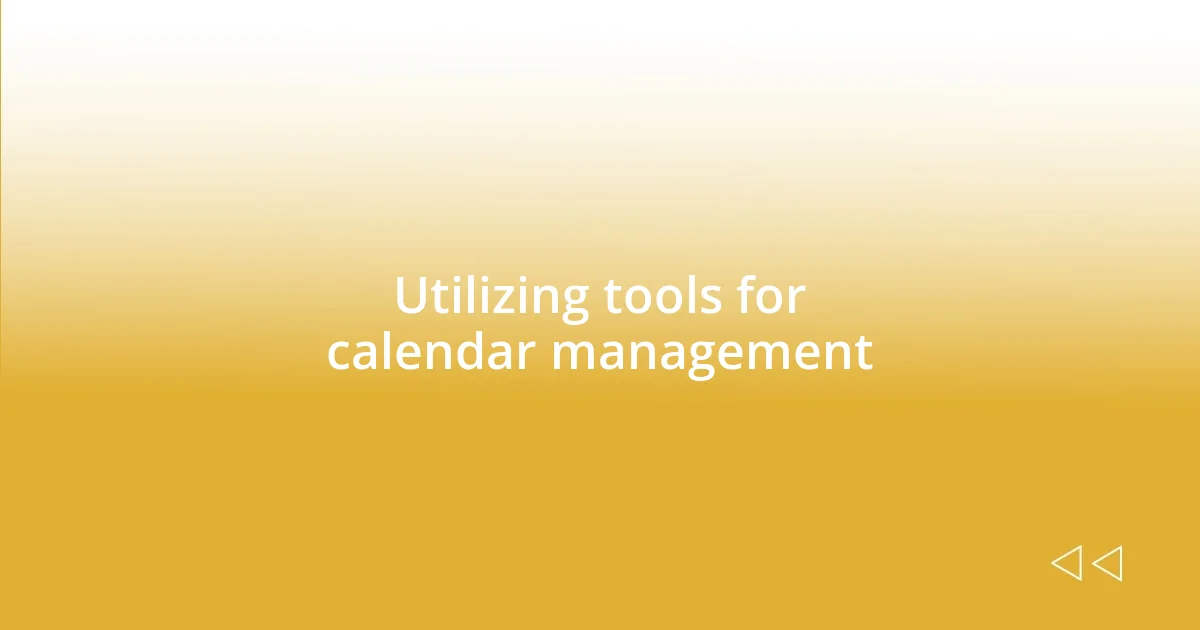
Utilizing tools for calendar management
Utilizing calendar management tools can significantly streamline your fundraising efforts. When I first discovered digital calendars, I was genuinely surprised at how much they simplified scheduling. I began using shared calendar platforms, which allowed my team to access and update our fundraising calendar in real-time. This shared visibility fostered collaboration and kept everyone on the same page. Have you ever felt that rush of relief when you see all your tasks laid out clearly? It was liberating!
I also experimented with task management applications that integrated seamlessly with my calendar. Adding reminders and deadlines was another game-changer. During one particular campaign, I set up notifications for each milestone we aimed to hit. When those reminders popped up, it motivated me and my team to stay on track, and I can honestly say that it kept the energy high leading up to our events. How do you keep your team accountable? Tools like these can not only boost productivity but also create a sense of urgency around your goals.
Moreover, I realized the power of color-coding within my calendar. By assigning colors to different types of activities—like donor outreach, event planning, and follow-ups—I could quickly identify where I needed to focus my efforts. I remember one chaotic week where I had a fundraising event and a major donor meeting close together. Thanks to my color-coded strategy, I adjusted my priorities beforehand and ultimately delivered successful experiences at both. Isn’t it fascinating how a little organization can make such a significant difference in managing your time?
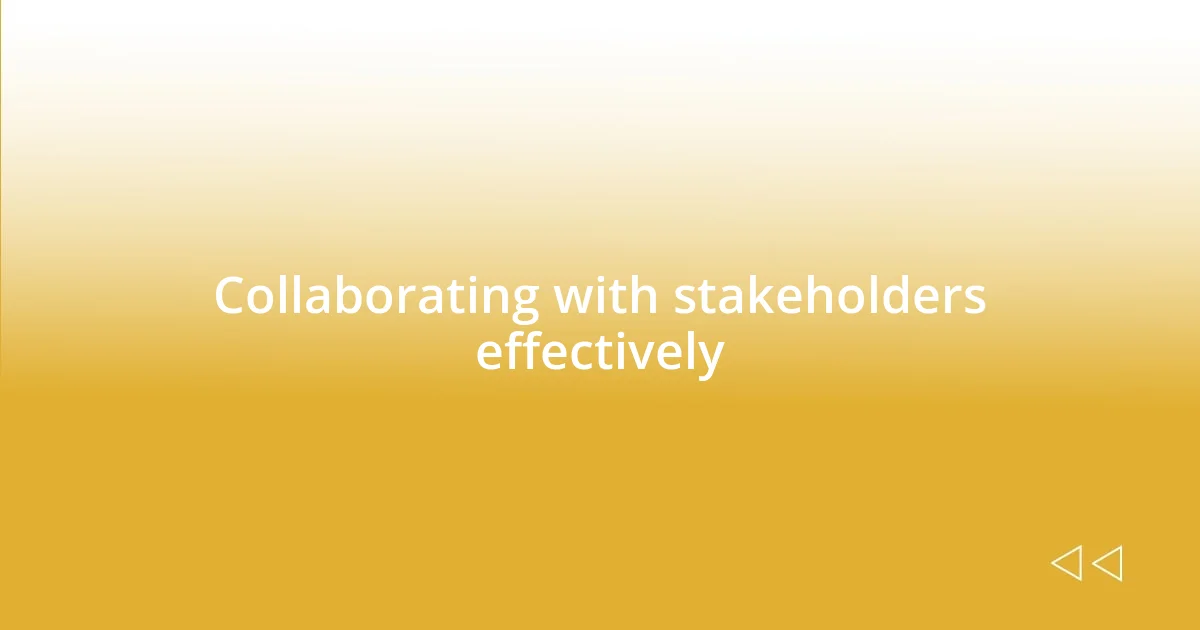
Collaborating with stakeholders effectively
When it comes to collaborating with stakeholders effectively, I’ve found that clear communication is key. During one fundraising campaign, I organized a series of meetings where everyone had the opportunity to share their ideas and concerns. This open dialogue not only built trust but also allowed us to leverage the diverse perspectives of our team. Have you experienced that moment when a group’s collective input leads to a breakthrough idea? I certainly have, and it’s exhilarating!
Building strong relationships with stakeholders is another crucial aspect of effective collaboration. I remember reaching out to our core partners to discuss the calendar. By genuinely listening to their insights, we identified unique fundraising opportunities that aligned with their goals. When we realized we could combine efforts on an event, it not only strengthened our partnership but also amplified our outreach. It’s incredible how forging deeper connections can reveal unexpected synergies, isn’t it?
Lastly, I learned the importance of creating a shared vision. When we embarked on our calendar planning, I crafted a simple one-page document summarizing our goals and approach. Sharing this with stakeholders inspired a sense of unity. During a feedback session, I saw the spark in everyone’s eyes as they recognized how their contributions fit into the bigger picture. Don’t you think having a common goal can transform the way you work together? Feeling that collective energy makes all the difference in driving your fundraising efforts forward.
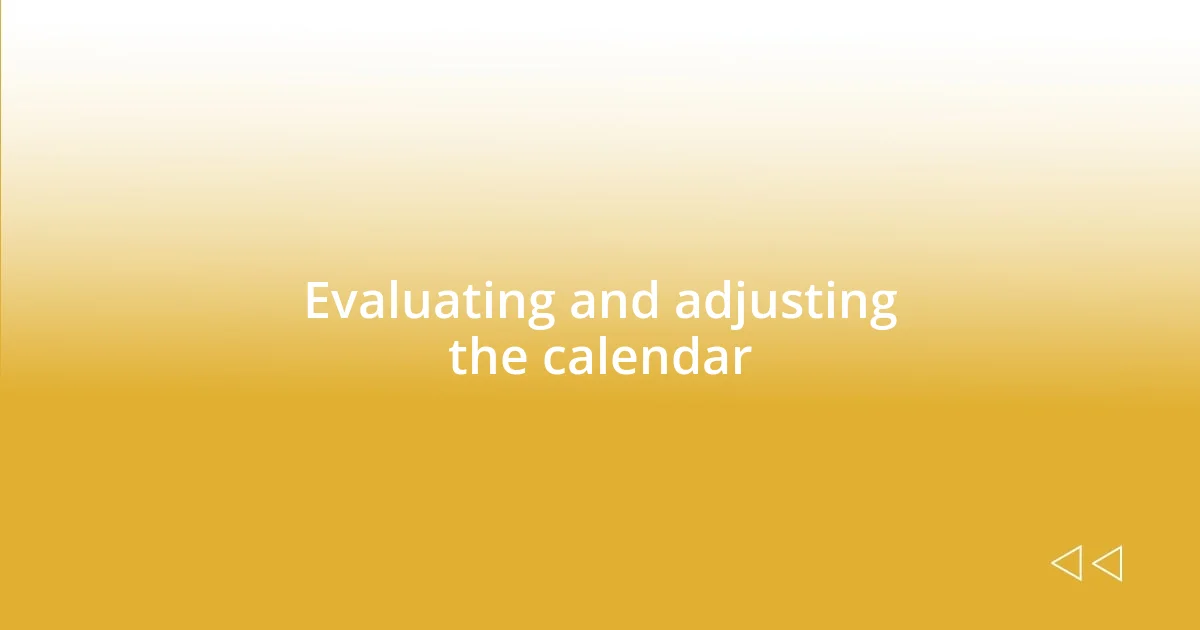
Evaluating and adjusting the calendar
Evaluating and adjusting the fundraising calendar is something I approach with both reflection and strategy. After each major event, I take time to assess what worked and what didn’t. For example, following a particularly successful gala, I realized our follow-up with attendees could have been more streamlined. By adding a post-event debriefing to our calendar, I ensured that we could build on our successes and learn from any missteps. Isn’t it amazing how a little critical thinking can pave the way for future improvements?
Another key aspect is staying flexible. I remember a time when an unexpected opportunity arose just days before an annual campaign. Instead of sticking rigidly to our original timeline, I quickly adjusted the calendar to incorporate this new event. The result? We generated significant interest and increased engagement. It taught me that while planning is essential, being adaptable can lead to unexpected rewards. How often do we miss out because we cling too tightly to our initial plan?
Lastly, I make it a habit to gather feedback regularly from my team. One month, we realized that certain activities felt cramped and pressured. By discussing it openly, we made a few shifts, such as spacing out our outreach efforts and allowing more time for preparation. The energy of the team shifted, and our productivity skyrocketed. Does your calendar serve your team’s needs, or is it holding you back? I’ve found that an evolving calendar not only helps manage tasks better but also boosts overall morale—it’s a win-win in the fundraising world!










